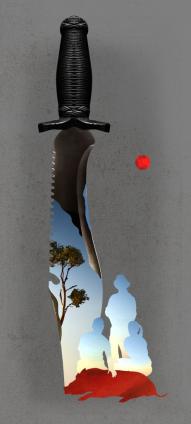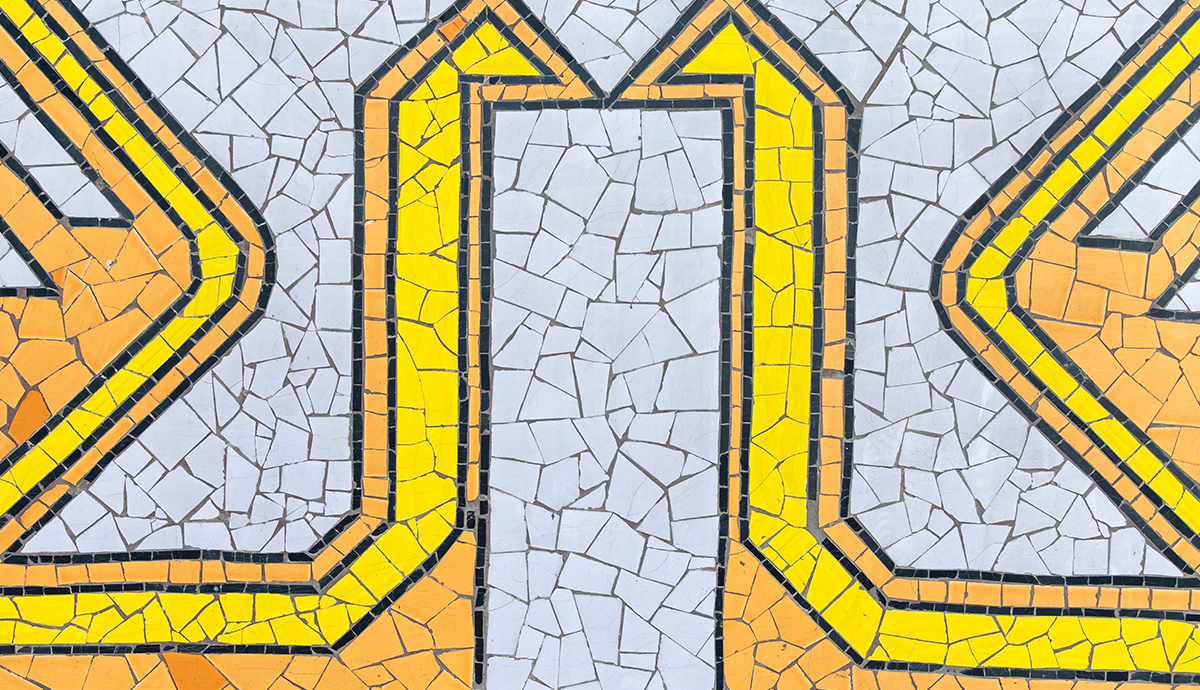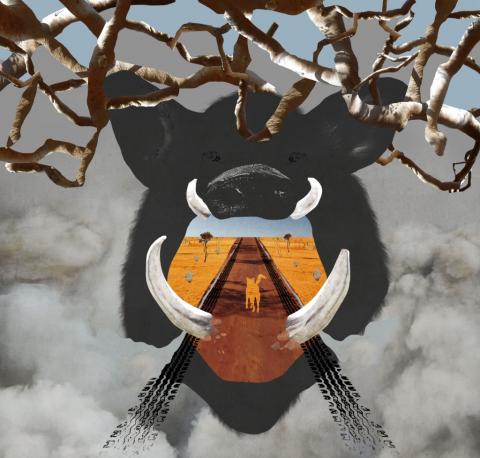There’s an entry in my diary from August 2014. I remember writing it. I was propped up on the bed of an old caravan I’d rented and which sat smack bang in the middle of a wildlife park in the Northern Territory, Australia, where I was researching for a novel about animals. The wildlife park housed thousands of captive native animals—crocodiles, endangered northern quolls, microbats. But wild animals had made their home there too. As I wrote in the diary, a wild barking owl “woofed” overhead to a captive one below. In the day, a 3.5 meter olive python would sun herself outside the caravan, across my only access to the bathroom. There were other animals. Introduced wild pigs roamed the bush, and pig hunters chased them—whole communities had risen up out of the “sport.” I met some of these guys, and was taken to a hunting competition called “Dog a Hog”, held at a remote bar one baking Northern Territory day. This day and a hunt that came a few weeks later were the experiences that I wrote about in the diary, and eventually became a short story, called “Territory”. . .
Diary excerpt, 4 August 2014, 9:02 PM, Northern Territory, Australia
The place is orange, the pigs black—except for those that have swelled in the sun to reveal their pink skin. And there are games, let me tell you. We arrive midafternoon at Dog a Hog—an unadvertised event that is known by word of mouth through the pigging community—and within twenty minutes we are part of the games. Like pigging, the games have rules and they are this: team up with a mate (or, in the “Jack and Jill” section, with someone of the opposite sex), drink a warm beer each, eat a cold (not heated and gone cold but defrosted) meat pie each, grab the leg of a dead pig and run across a paddock with it. Drinking a warm beer on a hot day is nothing. Picking up the leg of a dead pig, whose fur is stiff with dried blood and dragging it across a paddock, first with another woman and then with my husband Tom, might seem like a big deal. But nothing, nothing, is as difficult as eating that defrosted pie. Because of this, we come last in the women’s section. There are calls of “Come on girls!” and “You can do it.” Supportive calls. The kind I heard recently at my niece’s soccer match. The taste of the pie and the feel of the pig I am dragging through the dust. Dragging a fellow mammal through the dust.
As the games go on, the pigs are dismantled. Later on there is a pig-leg-throwing competition for the kids. One kid stands absentmindedly toying with a pig leg with his bare foot. Rolling it forward and back like a football along the ground. We see every stage of the pig here: the live pig tearing through the bush, the pig dying as it is stabbed and its blood let, the disemboweled pig, the dead pig being weighed up for competition, the dragged pig, the thrown leg of the pig and, finally, the pig (a different pig, but still a pig) on a plate for dinner.
After the games, the sun beats out a late afternoon sting and the men in the crowd are so bloated pink, so like the pigs. They stand close and grin through their inebriation. Then, in a blink, one has punched the other in the face and it is on. They are enormous and scuffling in the dust. I expect one of the pig dogs to leap from a truck and grab one of them by the ear, tuck itself into the body while a man grabs his legs from behind and another sticks his throat. They punch back and forth and seem to lose momentum. Then another man flies in and smashes a beer can on one of the fighters’ faces.
The emcee gets on the mic.
“This is a family day,” he reminds everyone sternly, “if you fight here, you’re out of the competition for the next few years.”
Half the crowd claps approvingly, the other half push each other to “calm down.” As the day burns on, men stumble over walking. The line to the ladies’ toilets gets longer. The stink increases. The pub gets busier and the crowd throwing bits of pig around at the games thins. Women take their children home after heated arguments with their partners, who have decided to stay, with no way of getting home later since everyone else is beyond inebriation, beyond speech, just fists and skin. The mosquitos arrive at dusk and find me. My legs are too tired and my ears hurt from listening, from trying to fit in.
“Laura looks like she’s at Nimbin (the pot smoking capital of Australia),” Trent tells Tom, but he gives me a bourbon and coke and tells me and Tom to come into the pub. We make our way through the crowd. Ninety percent of the people there are covered in pig guts.
‘There’s going to be some really gross sex tonight,’ Tom tells me as we find seats, and we shudder.
And even when we get home, I cannot get the smell out of my nose. Not after a hot shower. Not after scrubbing my feet. Not after I fall asleep. I still can’t describe it. Colors? Yellow, like Tom said? Sweet. The description is of rotting pork, I suppose, and you either do or don’t know it.
Laura Jean McKay is the author of Holiday in Cambodia (Black Inc., 2013), a story collection that explores the electric zone where local and foreign lives meet. Holiday in Cambodia has been shortlisted for three national book awards in Australia, including the New South Wales Premier’s Literary Awards, the Queensland Literary Awards and the Asher Award 2015 for books on an antiwar theme. Her work has appeared in The Best Australian Stories, Award Winning Australian Writing, Words Without Borders and is forthcoming in J Journal. Laura is also the winner of the Alan Marshall Short Story Award, an Asialink and Martin Bequest Scholarship recipient, and is currently a PhD candidate at the University of Melbourne, Australia. www.laurajeanmckay.com
Illustrations by Anthony Tremmaglia. He is an illustrator, artist, and educator based in Ottawa. Inspired by the complexities of the everyday human experience, Tremmaglia combines texture, drawing, and photographs in multi-layered works that underscore the paradox of our conflicting desires to both assimilate and break free. Tremmaglia was born in 1976 and graduated from the Advanced Illustration program at Toronto’s Sheridan College.



